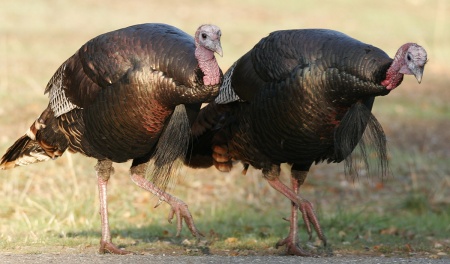- Meleagris gallopavo
Identification
Featherless, red head and throat.
- Long red-orange to grey-blue legs
- Dark-brown to black body
- The head has fleshy growths.
- Males have red wattles on the throat and neck and rear spurs on their lower legs.
- Long, dark, fan-shaped tail and glossy bronze wings.
- Female feathers are duller overall, in shades of brown and grey.
Due to hunting and other pressures, wild turkeys were in serious decline at the beginning of the 20th Century, but with conservation measures and management, have rebounded to a healthy population. They are still hunted throughout the U.S.
Distribution
United States and Mexico. Feral birds found around the world.
Taxonomy
Six subspecies are recognized:[1]
- M. g. silvestris - Central and eastern USA
- M. g. osceola - Florida (local)
- M. g. intermedia - North Texas to east-central Mexico
- M. g. merriami - Western USA
- M. g. mexicana - Sierra Madre mountains, central Mexico
- M. g. gallopavo - Southern Mexico
Habitat
Woods, open woods, fields, pastures, and shrubby growth.

Usual foraging appearance. Photo by Gary Clark
Location: Del Valle Regional Park, Livermore, California, USA.
Location: Del Valle Regional Park, Livermore, California, USA.
Behaviour
Forages in small flocks, moving continuously over fairly large areas in search for food.
- Diet: 80% grass, but also includes acorns, nuts, seeds, berries, roots and insects.
- Breeding: The nest is a shallow dirt depression covered with woody vegetation. 10-14 eggs are laid, usually one per day. The eggs are incubated for at least 28 days. Males are polygamous, mating with as many females as they can.
- Voice:They make a variety of sounds, including the distinctive, loud gobble-gobble-gobble, which carries for considerable distance.
References
- Clements, JF. 2008. The Clements Checklist of Birds of the World. 6th ed., with updates to December 2008. Ithaca: Cornell Univ. Press. ISBN 978-0801445019.
Recommended Citation
- BirdForum Opus contributors. (2024) Wild Turkey. In: BirdForum, the forum for wild birds and birding. Retrieved 1 November 2024 from https://www.birdforum.net/opus/Wild_Turkey




